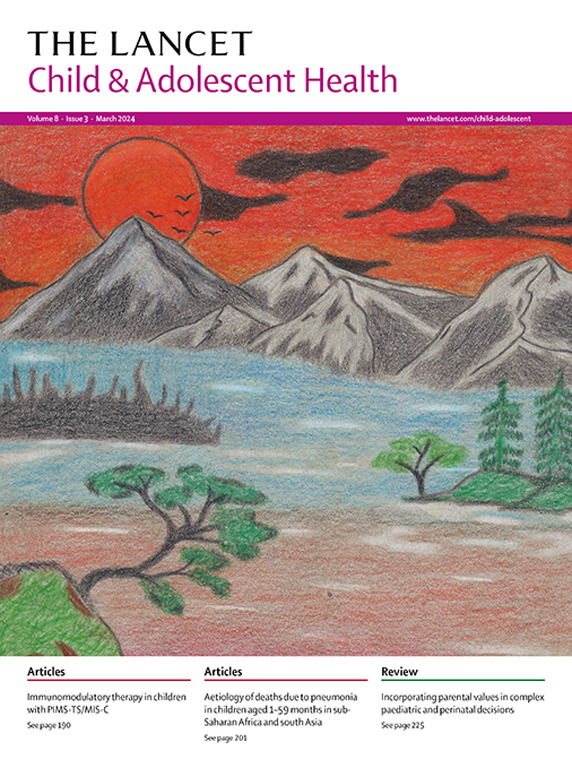英格兰符合 1+1 与 2+1 PCV13 婴儿免疫接种计划条件的侵袭性肺炎球菌疾病患儿的特征:一项前瞻性全国观察监测研究。
IF 19.9
1区 医学
Q1 PEDIATRICS
引用次数: 0
摘要
背景:自 2020 年 1 月 1 日起,英国开始将 13 价肺炎球菌结合疫苗 (PCV13) 的全国婴儿免疫接种计划从 2+1 过渡到 1+1。我们评估了 1+1 PCV13 计划是否会对符合条件的 0-3 岁儿童侵袭性肺炎球菌疾病(IPD)的发病率、疾病特征或预后产生影响:英国卫生安全局在英格兰通过全基因组测序对侵袭性肺炎球菌分离株进行 IPD 监测和血清分型。IPD的定义是在无菌部位发现肺炎链球菌。我们比较了符合 1+1 计划的单一出生队列(出生于 2020 年 1 月 1 日至 2022 年 12 月 31 日)中在 2022-23 财年(4 月至 3 月)患 IPD 的儿童与符合 2+1 计划的三个同等历史出生队列(出生于 2015 年 1 月 1 日至 2019 年 12 月 31 日)中在流行前三个财年患 IPD 的儿童的 IPD 发病率、人口统计学、临床表现、合并症流行率、血清型分布和病死率 (CFR):2017-18 年、2018-19 年和 2019-20 年。研究结果共有 697 名儿童发生了 702 例 IPD,其中单一 1+1 出生队列中有 158 例(发病率为每 100 000 人年 8-99 例),2+1 出生队列中有 544 例(发病率为每 100 000 人年 9-39 例)、总体 IPD(发病率比 0-96,95% CI 0-80-1-14,p=0-63)、PCV13 型 IPD(1-21,0-71-2-00,p=0-45)或肺炎球菌脑膜炎(0-97,0-66-1-40,p=0-88)的发病率无明显差异。两组病例的合并症发生率、临床表现和 CFRs 也相似,年龄太小而无法接种疫苗的婴儿的病例比例也相似(解释:1+1 接种方案在 3 年后将被淘汰:3年后,1+1接种方案仍能直接或间接保护儿童免受PCV13型IPD感染,与2+1接种方案相比,符合1+1接种条件的儿童的IPD总发病率、血清型分布、临床表现或CFR均无明显变化。持续监测对于评估较长期的直接和间接人群保护非常重要:无。本文章由计算机程序翻译,如有差异,请以英文原文为准。
Characteristics of children with invasive pneumococcal disease eligible for the 1+1 compared with the 2+1 PCV13 infant immunisation schedule in England: a prospective national observational surveillance study
Background
On Jan 1, 2020, the UK transitioned from a 2+1 to a 1+1 national infant immunisation schedule with the 13-valent pneumococcal conjugate vaccine (PCV13). We assessed whether the 1+1 PCV13 schedule had any impact on incidence, disease characteristics, or outcomes after invasive pneumococcal disease (IPD) in eligible children aged 0–3 years.
Methods
The UK Health Security Agency conducts IPD surveillance and serotyping of invasive pneumococcal isolates via whole-genome sequencing in England. IPD was defined as identification of Streptococcus pneumoniae in a sterile site. We compared IPD incidence, demographics, clinical presentation, comorbidity prevalence, serotype distribution, and case-fatality rates (CFRs) in children from a single birth cohort eligible for the 1+1 schedule (born between Jan 1, 2020, and Dec 31, 2022) who developed IPD in the 2022–23 financial year (April to March) with children from three equivalent historical birth cohorts (born between Jan 1, 2015, and Dec 31, 2019) eligible for the 2+1 schedule who developed IPD during three respective pre-pandemic financial years: 2017–18, 2018–19, and 2019–20.
Findings
There were a total of 702 IPD episodes in 697 children, including 158 (incidence 8·99 per 100 000 person-years) in the single 1+1 birth cohort and 544 (incidence 9·39 per 100 000 person-years) in the 2+1 birth cohorts, with no significant difference in the incidence of overall IPD (incidence rate ratio 0·96, 95% CI 0·80–1·14, p=0·63), PCV13-type IPD (1·21, 0·71–2·00, p=0·45), or pneumococcal meningitis (0·97, 0·66–1·40, p=0·88). Comorbidity prevalence, clinical presentation, and CFRs were also similar between the two cohorts, as was the percentage of cases in infants too young to be vaccinated (<2 months old) and infants aged 5–11 months who received one or two PCV13 priming doses, in the 1+1 and 2+1 cohorts respectively.
Interpretation
After 3 years, the 1+1 schedule continues to provide direct and indirect protection against PCV13-type IPD in children, with no significant change in overall IPD incidence, serotype distribution, clinical presentation, or CFRs in children eligible for the 1+1 compared with the 2+1 schedule. Ongoing surveillance will be important to assess longer-term direct and indirect population protection.
Funding
None.
求助全文
通过发布文献求助,成功后即可免费获取论文全文。
去求助
来源期刊

Lancet Child & Adolescent Health
Psychology-Developmental and Educational Psychology
CiteScore
40.90
自引率
0.80%
发文量
381
期刊介绍:
The Lancet Child & Adolescent Health, an independent journal with a global perspective and strong clinical focus, presents influential original research, authoritative reviews, and insightful opinion pieces to promote the health of children from fetal development through young adulthood.
This journal invite submissions that will directly impact clinical practice or child health across the disciplines of general paediatrics, adolescent medicine, or child development, and across all paediatric subspecialties including (but not limited to) allergy and immunology, cardiology, critical care, endocrinology, fetal and neonatal medicine, gastroenterology, haematology, hepatology and nutrition, infectious diseases, neurology, oncology, psychiatry, respiratory medicine, and surgery.
Content includes articles, reviews, viewpoints, clinical pictures, comments, and correspondence, along with series and commissions aimed at driving positive change in clinical practice and health policy in child and adolescent health.
 求助内容:
求助内容: 应助结果提醒方式:
应助结果提醒方式:


